Race tightens in British Columbia as CPC support grows, Liberals’ strength in Ontario and Quebec holds
April 14, 2025 – As the runway shortens for all parties to make gains and lock in votes in this federal election campaign, new data from the Angus Reid Institute shows the race tightening between the incumbent Liberals and the challenger Conservatives.
For the CPC, these data represent the first glimmer of hope in several weeks, as their support ticks up ever so slightly, while Liberal support remains statistically unchanged, though down a point to 45 per cent.
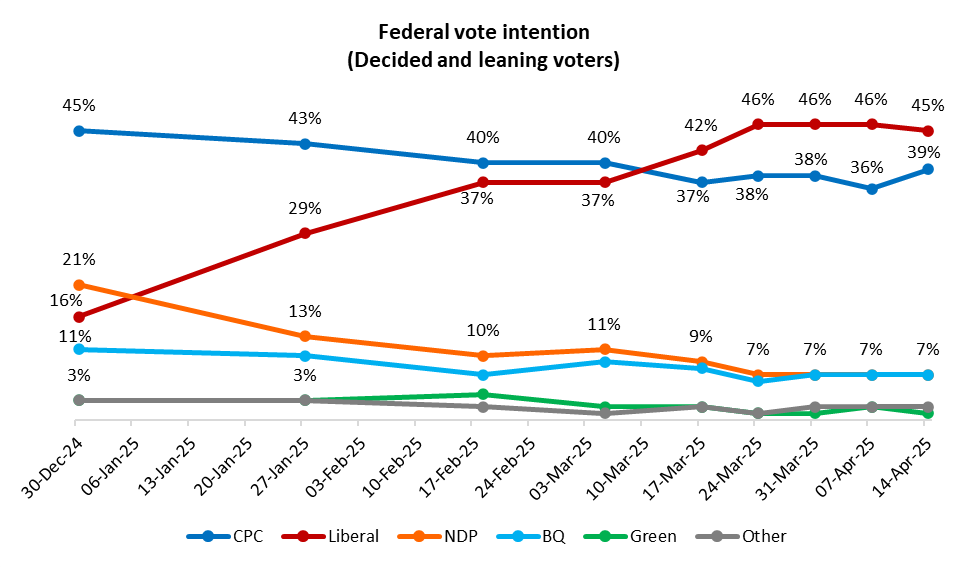
However, the reasons driving this movement reveals more about the state of the campaign than topline vote intent data. The shift may be attributed to three key things.
First, the issues: concern over cost of living and inflation has been climbing since the start of the campaign, up to 56 per cent now, while worries about tariff threats and managing the Trump-Canada relationship has declined, off 12 points in the last month.
This latter issue especially has represented a stronghold of Liberal support in recent weeks. Its diminishment in the minds of Canadians opens space for voters to change their minds.
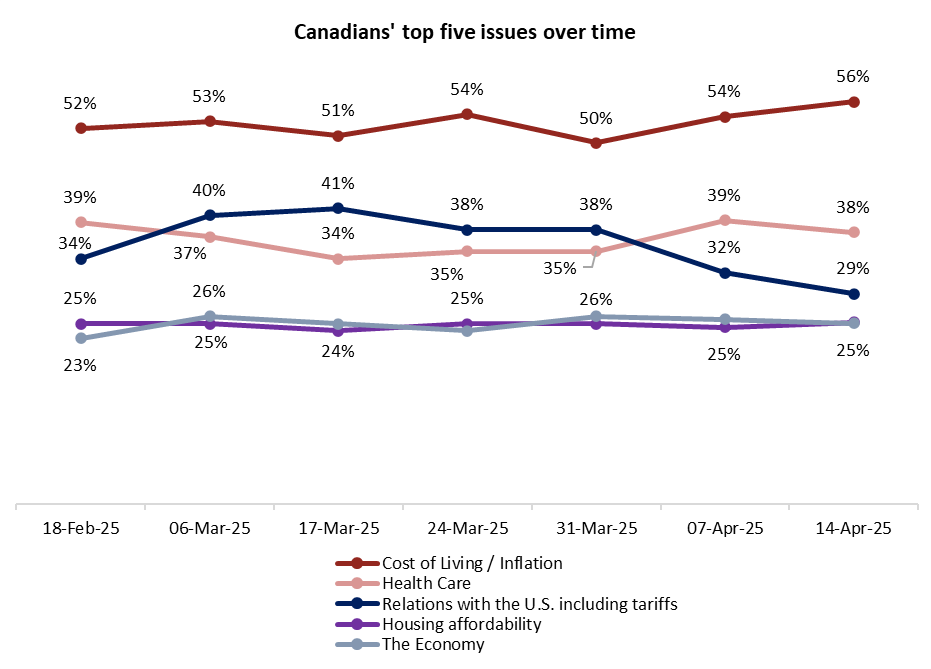
Secondly, the personal momentum of Prime Minister and Liberal leader Mark Carney – the difference between improving and worsening opinions among Canadians – has slowed to a neutral pace. Canadians are as likely to say their opinion of him has improved (33%) as worsened (31%) over the past week. In recent weeks, Carney had been generating more positive impressions. However, he still holds an advantage over CPC leader Pierre Poilievre and NDP leader Jagmeet Singh on this metric, both of whom have negative momentum (-20, -27 respectively).
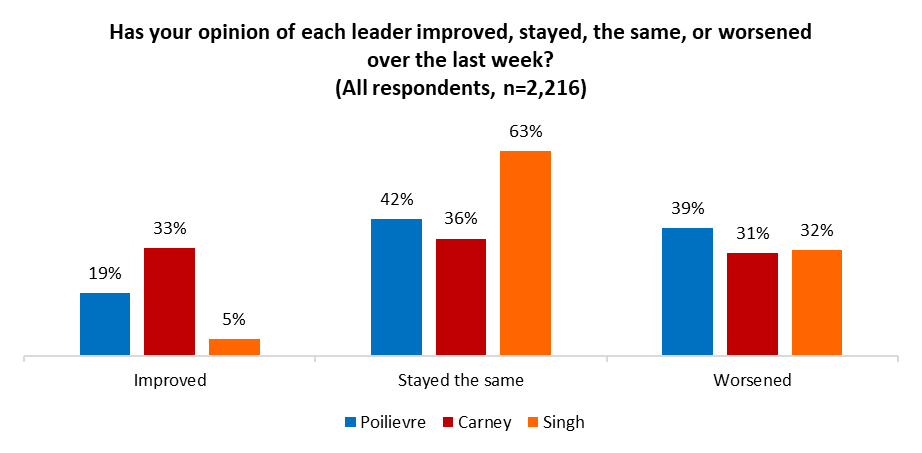
And third, a noticeable shift among some men back to the CPC. If the first weeks of the campaign were notable for the number of men willing to give the Liberals another look post-Trudeau departure, the second half may well be defined by the Conservatives’ attempts – which appear to be bearing fruit – to communicate directly to and woo back male voters. The CPC have regained the lead over the Liberals among men older than 54 (+7), while still leading among men aged 35 to 54 (+9).

About ARI
The Angus Reid Institute (ARI) was founded in October 2014 by pollster and sociologist, Dr. Angus Reid. ARI is a national, not-for-profit, non-partisan public opinion research foundation established to advance education by commissioning, conducting and disseminating to the public accessible and impartial statistical data, research and policy analysis on economics, political science, philanthropy, public administration, domestic and international affairs and other socio-economic issues of importance to Canada and its world.
Part Two: CPC recovers three points, trails by six
This unorthodox campaign saw Liberal Leader and Prime Minister Mark Carney thrust into the national spotlight with opposition to U.S. President Donald Trump a paramount and growing concern. For Pierre Poilievre, the trusted playbook of anti-Justin Trudeau and anti-carbon tax messaging was undercut, as Trudeau resigned, and Carney ended the consumer carbon tax. Carney may now be facing a similar shift, as concern about the issue he has been viewed best on is dipping in prominence.
Annexation and tariff threats have cooled, after Canada escaped the most recent round of tariffs without additional targeting. Canadians appear to be responding to this, as the proportion of those choosing U.S. relations and tariffs as a top issue has dropped 12 points in the past month. Health care has returned to the place it has occupied for most of the last few years as the second most important area of concern for residents. Growing, too, is the proportion of those who say that the cost of living and inflation is among their top concerns:
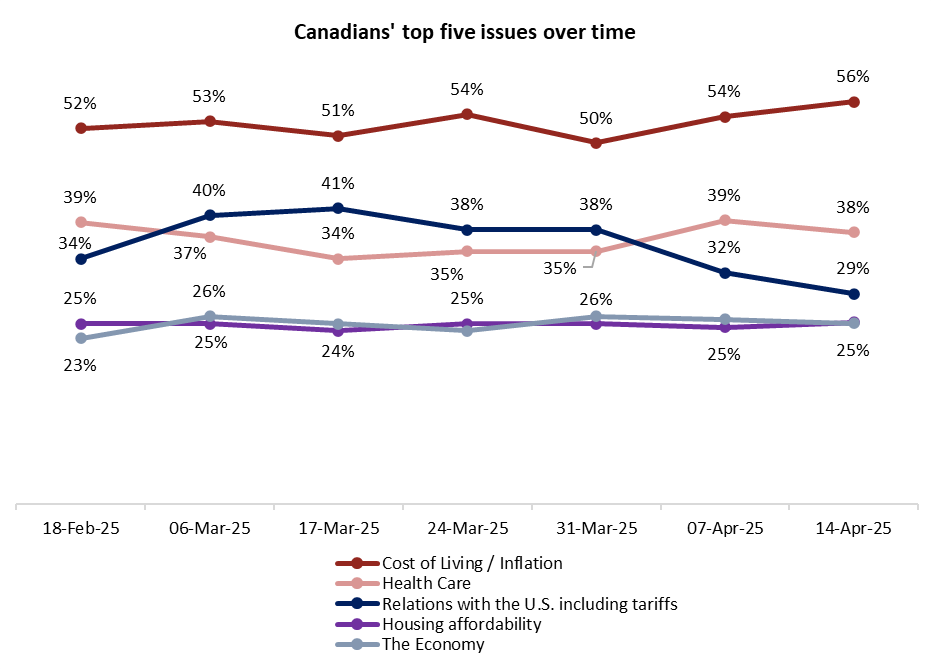
While Carney was seen as best on these top issues in a faceoff with Poilievre earlier in the campaign, the rigours of the campaign and party messaging mean this race may be shifting slightly. The Conservatives have inched up three-points this week, cutting the Liberal advantage back to single digits. Asked how they plan to vote in this election, 45 per cent say they will support the Liberals, with 39 per cent planning to vote Conservative. NDP support has not recovered and holds at seven per cent this week, tied with the Bloc Québécois:


However, the reasons driving this movement reveals more about the state of the campaign than topline vote intent data. The shift may be attributed to three key things.
First, the issues: concern over cost of living and inflation has been climbing since the start of the campaign, up to 56 per cent now, while worries about tariff threats and managing the Trump-Canada relationship has declined, off 12 points in the last month.
This latter issue especially has represented a stronghold of Liberal support in recent weeks. Its diminishment in the minds of Canadians opens space for voters to change their minds.

Secondly, the personal momentum of Prime Minister and Liberal leader Mark Carney – the difference between improving and worsening opinions among Canadians – has slowed to a neutral pace. Canadians are as likely to say their opinion of him has improved (33%) as worsened (31%) over the past week. In recent weeks, Carney had been generating more positive impressions. However, he still holds an advantage over CPC leader Pierre Poilievre and NDP leader Jagmeet Singh on this metric, both of whom have negative momentum (-20, -27 respectively).

And third, a noticeable shift among some men back to the CPC. If the first weeks of the campaign were notable for the number of men willing to give the Liberals another look post-Trudeau departure, the second half may well be defined by the Conservatives’ attempts – which appear to be bearing fruit – to communicate directly to and woo back male voters. The CPC have regained the lead over the Liberals among men older than 54 (+7), while still leading among men aged 35 to 54 (+9).

About ARI
The Angus Reid Institute (ARI) was founded in October 2014 by pollster and sociologist, Dr. Angus Reid. ARI is a national, not-for-profit, non-partisan public opinion research foundation established to advance education by commissioning, conducting and disseminating to the public accessible and impartial statistical data, research and policy analysis on economics, political science, philanthropy, public administration, domestic and international affairs and other socio-economic issues of importance to Canada and its world.
INDEX
Part One: Top issue shiftPart Two: CPC recovers three points, trails by six
- Regional strength favours Liberals
- Gender gap grows
- Voter commitment still leaves room for movement
- Carney’s momentum in neutral
- Poilievre still has high negatives
Part One: Top issue shift
This unorthodox campaign saw Liberal Leader and Prime Minister Mark Carney thrust into the national spotlight with opposition to U.S. President Donald Trump a paramount and growing concern. For Pierre Poilievre, the trusted playbook of anti-Justin Trudeau and anti-carbon tax messaging was undercut, as Trudeau resigned, and Carney ended the consumer carbon tax. Carney may now be facing a similar shift, as concern about the issue he has been viewed best on is dipping in prominence.
Annexation and tariff threats have cooled, after Canada escaped the most recent round of tariffs without additional targeting. Canadians appear to be responding to this, as the proportion of those choosing U.S. relations and tariffs as a top issue has dropped 12 points in the past month. Health care has returned to the place it has occupied for most of the last few years as the second most important area of concern for residents. Growing, too, is the proportion of those who say that the cost of living and inflation is among their top concerns:

Part Two: CPC recovers three points, trails by six
While Carney was seen as best on these top issues in a faceoff with Poilievre earlier in the campaign, the rigours of the campaign and party messaging mean this race may be shifting slightly. The Conservatives have inched up three-points this week, cutting the Liberal advantage back to single digits. Asked how they plan to vote in this election, 45 per cent say they will support the Liberals, with 39 per cent planning to vote Conservative. NDP support has not recovered and holds at seven per cent this week, tied with the Bloc Québécois:

Regional strength favours Liberals
One of the most pronounced changes this week in in British Columbia, where the race has tightened. Poilievre campaigned in the B.C. Interior last week, holding a rally in Penticton, and visited the more northern city of Terrace where he promised to accelerate oil and gas projects if elected. Carney visited Victoria and met with B.C. Premier David Eby.
In Ontario, the Liberal Party still holds a key advantage, leading the Conservatives by 10 points. Meantime, in Quebec, CPC support dropped further this week, as the Liberals now hold a 12-point lead over the second place BQ:

Major urban centres continue to favour the Liberals, however, it should be noted that the Conservative Party has recovered some support in urban Toronto.
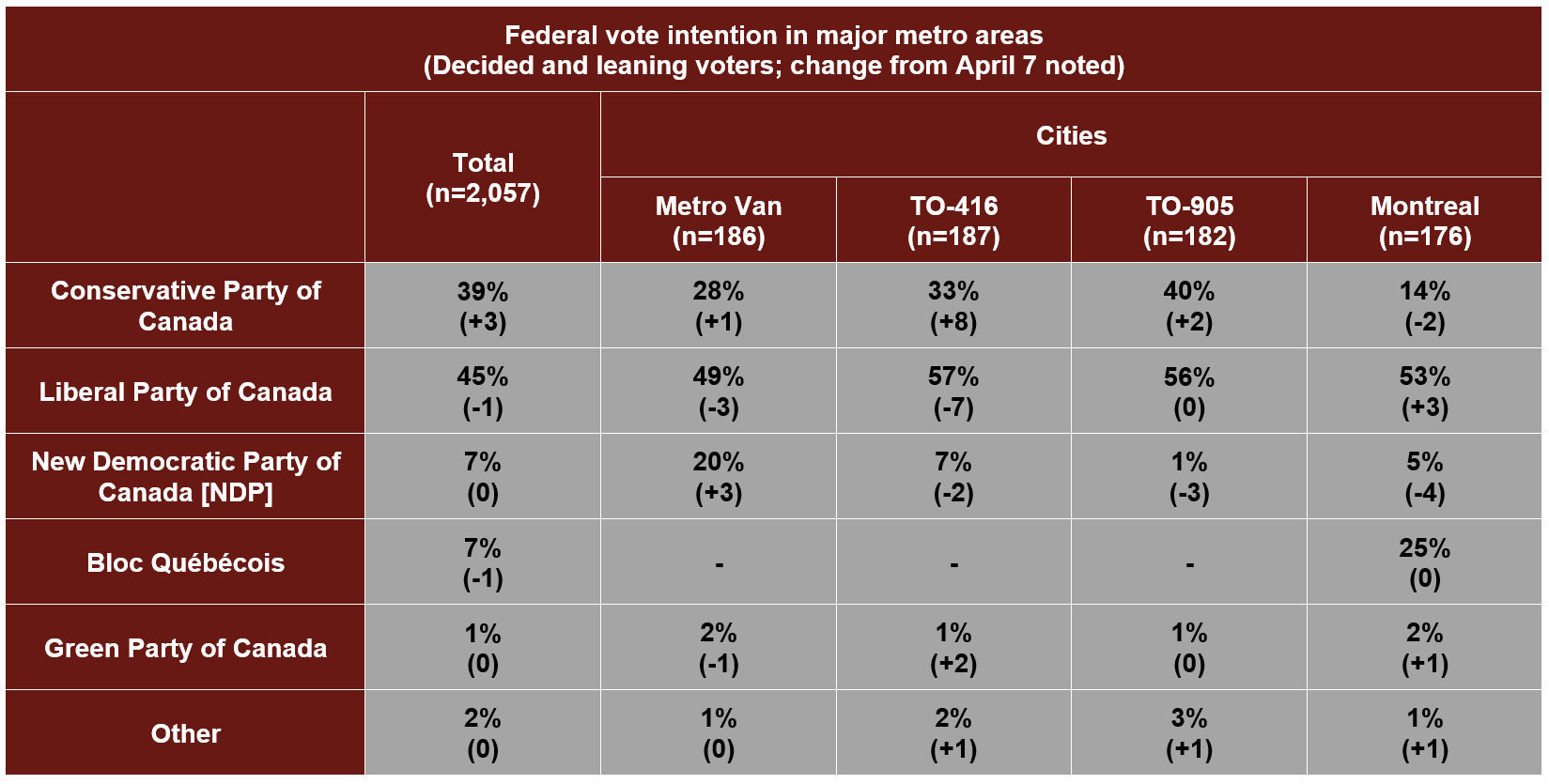
One of the most pronounced changes this week in in British Columbia, where the race has tightened. Poilievre campaigned in the B.C. Interior last week, holding a rally in Penticton, and visited the more northern city of Terrace where he promised to accelerate oil and gas projects if elected. Carney visited Victoria and met with B.C. Premier David Eby.
In Ontario, the Liberal Party still holds a key advantage, leading the Conservatives by 10 points. Meantime, in Quebec, CPC support dropped further this week, as the Liberals now hold a 12-point lead over the second place BQ:

Major urban centres continue to favour the Liberals, however, it should be noted that the Conservative Party has recovered some support in urban Toronto.

Gender gap grows
One of the defining aspects of this election campaign continues to be the gender gap. The CPC has gained among all male groups and leads among those over 34. Meantime, women of all ages offer a significant advantage to the Liberals – one that would lead them to form government if held:

One of the defining aspects of this election campaign continues to be the gender gap. The CPC has gained among all male groups and leads among those over 34. Meantime, women of all ages offer a significant advantage to the Liberals – one that would lead them to form government if held:

Voter commitment still leaves room for movement
While the Liberals lead in vote, the Conservative Party has the benefit of a more stable set of supporters. Three-quarters of the CPC vote say they are not going anywhere and will cast their ballot for the CPC. This translates to approximately 30 per cent as a committed portion of the electorate. Comparably, 63 per cent of Liberal voters say they’re very committed, which translates to approximately 28 per cent of the electorate. Thus, the Liberal Party ceiling is enviable, but the floor is precarious:

Among those who are hesitant to commit, the most common reason is an openness to new developments. Nearly half of uncommitted voters say they want to keep an open mind, while one-in-five are awaiting the debates this week (21%) or holding off to see if strategic voting is beneficial to their preferred outcome (23%):
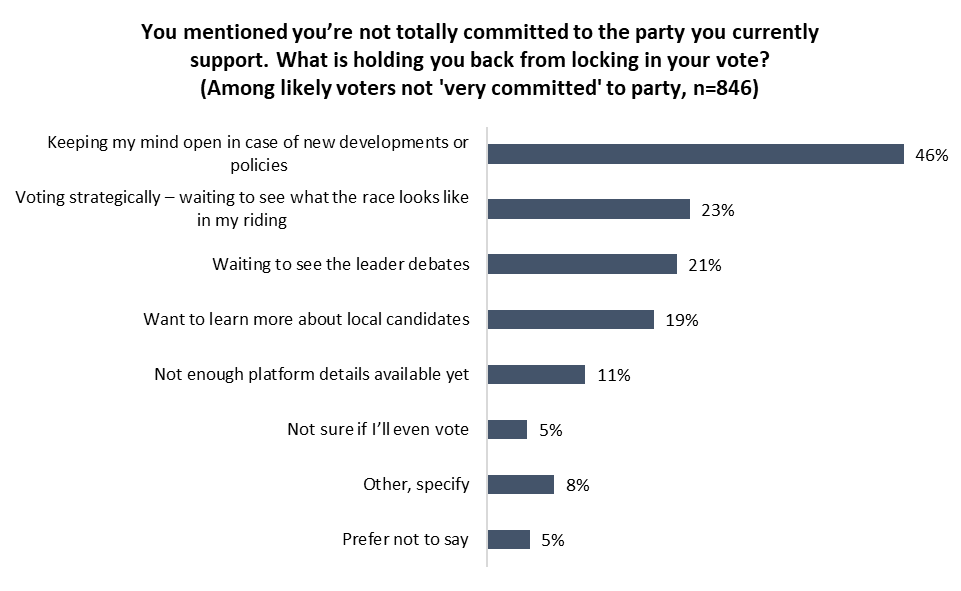
Canadians have now had more than a month to get to know Carney in his position as prime minister and Liberal leader. Over the past week, there are nearly as many Canadians who say their opinion of Carney has improved (33%), stayed the same (36%) or worsened (31%). Still, Carney has an advantage over his rivals on this front, as Canadians are more likely to report worsening opinions of Poilievre (39%) and NDP leader Jagmeet Singh (32%) than improving ones (19%, 5% respectively):
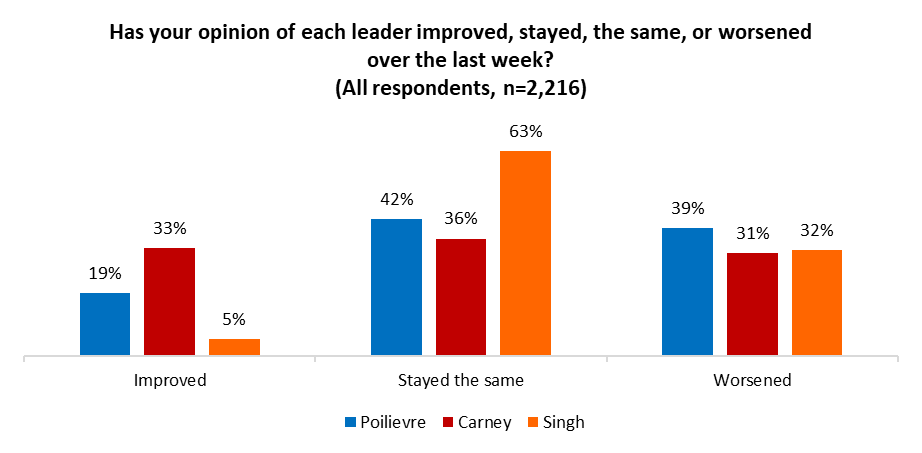
Carney’s neutral moment week over week is also evident on favourability: statistically similar numbers of Canadians say they have positive and negative impressions as last week. However, the gap between favourable and unfavourable views (+15) has narrowed from two weeks ago (+22):

While the Liberals lead in vote, the Conservative Party has the benefit of a more stable set of supporters. Three-quarters of the CPC vote say they are not going anywhere and will cast their ballot for the CPC. This translates to approximately 30 per cent as a committed portion of the electorate. Comparably, 63 per cent of Liberal voters say they’re very committed, which translates to approximately 28 per cent of the electorate. Thus, the Liberal Party ceiling is enviable, but the floor is precarious:

Among those who are hesitant to commit, the most common reason is an openness to new developments. Nearly half of uncommitted voters say they want to keep an open mind, while one-in-five are awaiting the debates this week (21%) or holding off to see if strategic voting is beneficial to their preferred outcome (23%):

Part Three: Leadership
Carney’s momentum neutralCanadians have now had more than a month to get to know Carney in his position as prime minister and Liberal leader. Over the past week, there are nearly as many Canadians who say their opinion of Carney has improved (33%), stayed the same (36%) or worsened (31%). Still, Carney has an advantage over his rivals on this front, as Canadians are more likely to report worsening opinions of Poilievre (39%) and NDP leader Jagmeet Singh (32%) than improving ones (19%, 5% respectively):

Carney’s neutral moment week over week is also evident on favourability: statistically similar numbers of Canadians say they have positive and negative impressions as last week. However, the gap between favourable and unfavourable views (+15) has narrowed from two weeks ago (+22):

Poilievre still has high negatives
But there remains a huge likability gap between the two men contending for the job of prime minster as things stand. Three-in-five (60%) Canadians say they have an unfavourable view of Poilievre, a record high repeated from last week. While there is still time left in the campaign, the CPC leader has yet to find a way to appeal to any more than two-in-five Canadians at any point during his tenure:
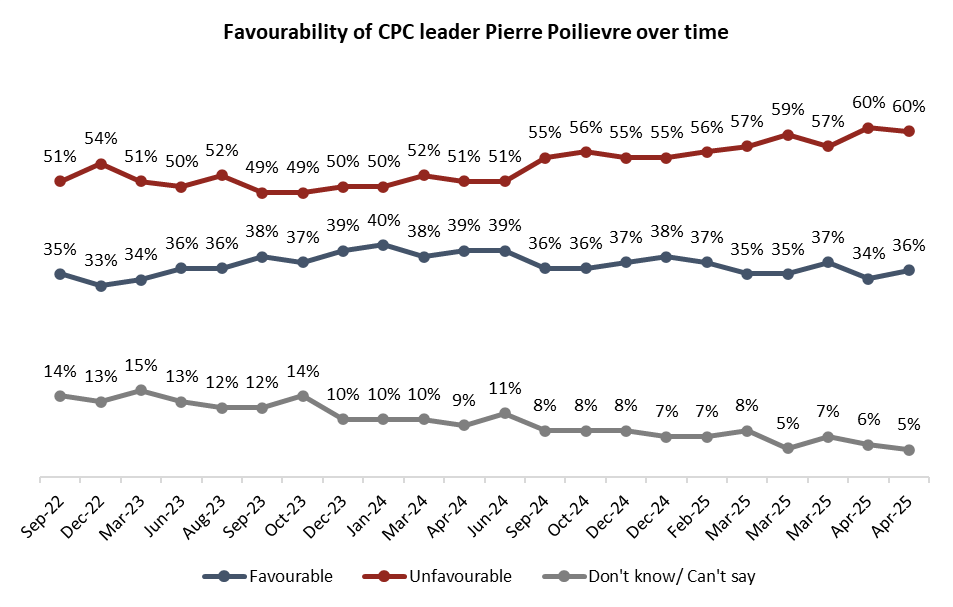
But there remains a huge likability gap between the two men contending for the job of prime minster as things stand. Three-in-five (60%) Canadians say they have an unfavourable view of Poilievre, a record high repeated from last week. While there is still time left in the campaign, the CPC leader has yet to find a way to appeal to any more than two-in-five Canadians at any point during his tenure:

Survey Methodology:
The Angus Reid Institute conducted an online survey from April 10-13, 2025, among a randomized sample of 2,216 Canadian adults who are members of Angus Reid Forum. The sample was weighted to be representative of adults nationwide according to region, gender, age, household income, and education, based on the Canadian census. For comparison purposes only, a probability sample of this size would carry a margin of error of +/- 2 percentage points, 19 times out of 20. Discrepancies in or between totals are due to rounding. The survey was self-commissioned and paid for by ARI.
For detailed results by age, gender, region, education, and other demographics, click here.
The Angus Reid Institute conducted an online survey from April 10-13, 2025, among a randomized sample of 2,216 Canadian adults who are members of Angus Reid Forum. The sample was weighted to be representative of adults nationwide according to region, gender, age, household income, and education, based on the Canadian census. For comparison purposes only, a probability sample of this size would carry a margin of error of +/- 2 percentage points, 19 times out of 20. Discrepancies in or between totals are due to rounding. The survey was self-commissioned and paid for by ARI.
For detailed results by age, gender, region, education, and other demographics, click here.


No comments:
Post a Comment